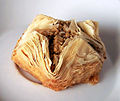Filo
Filo is a term that refers to a very thin unleavened dough used for making pastries such as baklava and börek in Middle Eastern and Balkan cuisines. Filo-based pastries are made by layering many sheets of filo brushed with oil or butter; the pastry is then baked.
History[edit]
The origins of filo are unclear, but it is a staple of Ottoman cuisine and has been a popular ingredient in Greek, Turkish, and Middle Eastern dishes for centuries. The dough is known for its paper-thin sheets, which are challenging to make without tearing.
Preparation[edit]
To prepare filo dough, a simple mixture of flour, water, a little oil, and sometimes vinegar or lemon juice is used. The dough is kneaded and then rolled out and stretched into large, thin sheets. The stretching is done carefully to ensure the sheets become thin enough to be almost transparent. The thin sheets are then used as layers in various dishes.
Uses[edit]
Filo is used in a variety of sweet and savory dishes. In sweets, it is most famously used in baklava, a rich, sweet dessert pastry made of layers of filo filled with chopped nuts and sweetened with syrup or honey. In savory dishes, filo is used in pies such as the Greek spanakopita (spinach pie) and the Turkish börek, which can be filled with cheese, minced meat, or vegetables.
Nutritional Information[edit]
Filo dough is low in fat and calories compared to other types of pastry dough, especially when brushed with oil rather than butter. However, the nutritional content of filo-based dishes can vary significantly depending on the fillings and the amount of oil or butter used in the recipe.
Variations[edit]
There are several variations of filo dough, including:
- Commercial Filo Dough: Available in frozen sheets, this version is convenient for quick preparation.
- Homemade Filo Dough: Made from scratch, offering a fresher taste but requiring more skill and time.
- Whole Wheat Filo Dough: A healthier option that includes whole wheat flour, providing more fiber.
Cultural Significance[edit]
Filo dough holds significant cultural importance in many Middle Eastern and Balkan countries. It is often used during special occasions and religious festivals to prepare traditional dishes. The skill of making filo dough from scratch is highly regarded and passed down through generations in many families.
See Also[edit]
-
Baklava
-
Bougatsa Athens
Ad. Transform your life with W8MD's Budget GLP-1 injections from $75


W8MD offers a medical weight loss program to lose weight in Philadelphia. Our physician-supervised medical weight loss provides:
- Weight loss injections in NYC (generic and brand names):
- Zepbound / Mounjaro, Wegovy / Ozempic, Saxenda
- Most insurances accepted or discounted self-pay rates. We will obtain insurance prior authorizations if needed.
- Generic GLP1 weight loss injections from $75 for the starting dose.
- Also offer prescription weight loss medications including Phentermine, Qsymia, Diethylpropion, Contrave etc.
NYC weight loss doctor appointmentsNYC weight loss doctor appointments
Start your NYC weight loss journey today at our NYC medical weight loss and Philadelphia medical weight loss clinics.
- Call 718-946-5500 to lose weight in NYC or for medical weight loss in Philadelphia 215-676-2334.
- Tags:NYC medical weight loss, Philadelphia lose weight Zepbound NYC, Budget GLP1 weight loss injections, Wegovy Philadelphia, Wegovy NYC, Philadelphia medical weight loss, Brookly weight loss and Wegovy NYC
|
WikiMD's Wellness Encyclopedia |
| Let Food Be Thy Medicine Medicine Thy Food - Hippocrates |
Medical Disclaimer: WikiMD is not a substitute for professional medical advice. The information on WikiMD is provided as an information resource only, may be incorrect, outdated or misleading, and is not to be used or relied on for any diagnostic or treatment purposes. Please consult your health care provider before making any healthcare decisions or for guidance about a specific medical condition. WikiMD expressly disclaims responsibility, and shall have no liability, for any damages, loss, injury, or liability whatsoever suffered as a result of your reliance on the information contained in this site. By visiting this site you agree to the foregoing terms and conditions, which may from time to time be changed or supplemented by WikiMD. If you do not agree to the foregoing terms and conditions, you should not enter or use this site. See full disclaimer.
Credits:Most images are courtesy of Wikimedia commons, and templates, categories Wikipedia, licensed under CC BY SA or similar.
Translate this page: - East Asian
中文,
日本,
한국어,
South Asian
हिन्दी,
தமிழ்,
తెలుగు,
Urdu,
ಕನ್ನಡ,
Southeast Asian
Indonesian,
Vietnamese,
Thai,
မြန်မာဘာသာ,
বাংলা
European
español,
Deutsch,
français,
Greek,
português do Brasil,
polski,
română,
русский,
Nederlands,
norsk,
svenska,
suomi,
Italian
Middle Eastern & African
عربى,
Turkish,
Persian,
Hebrew,
Afrikaans,
isiZulu,
Kiswahili,
Other
Bulgarian,
Hungarian,
Czech,
Swedish,
മലയാളം,
मराठी,
ਪੰਜਾਬੀ,
ગુજરાતી,
Portuguese,
Ukrainian

